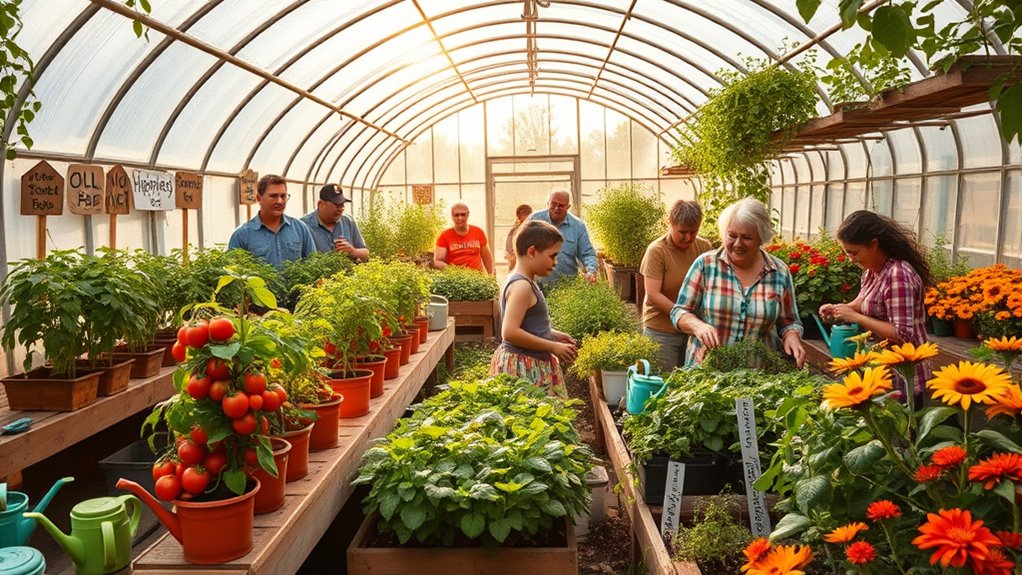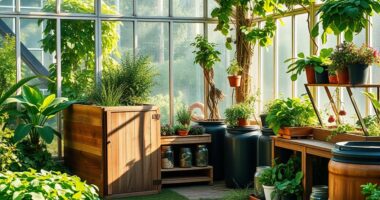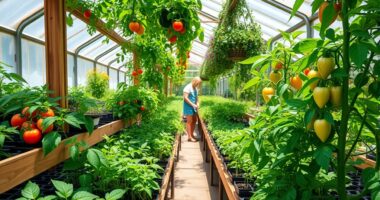Community greenhouses are valuable neighborhood resources that promote sustainability and foster social bonds. They turn vacant spaces into productive hubs for urban farming, education, and collaboration. These shared spaces help strengthen neighborhood ties, improve local food security, and inspire environmental awareness. Managing them involves planning, clear guidelines, and community effort. If you want to discover how these greenhouses transform communities and create sustainable, connected neighborhoods, explore the details further.
Key Takeaways
- Greenhouses serve as shared spaces that promote local food production and sustainability within neighborhoods.
- They foster community collaboration, education, and environmental awareness among residents.
- Shared greenhouses transform vacant spaces into productive hubs, enhancing urban biodiversity.
- They strengthen neighbor relationships through joint gardening projects and community activities.
- Innovative models like vertical farming and hydroponics increase efficiency and resilience of neighborhood green spaces.
The Rise of Community Greenhouses: A Sustainable Movement
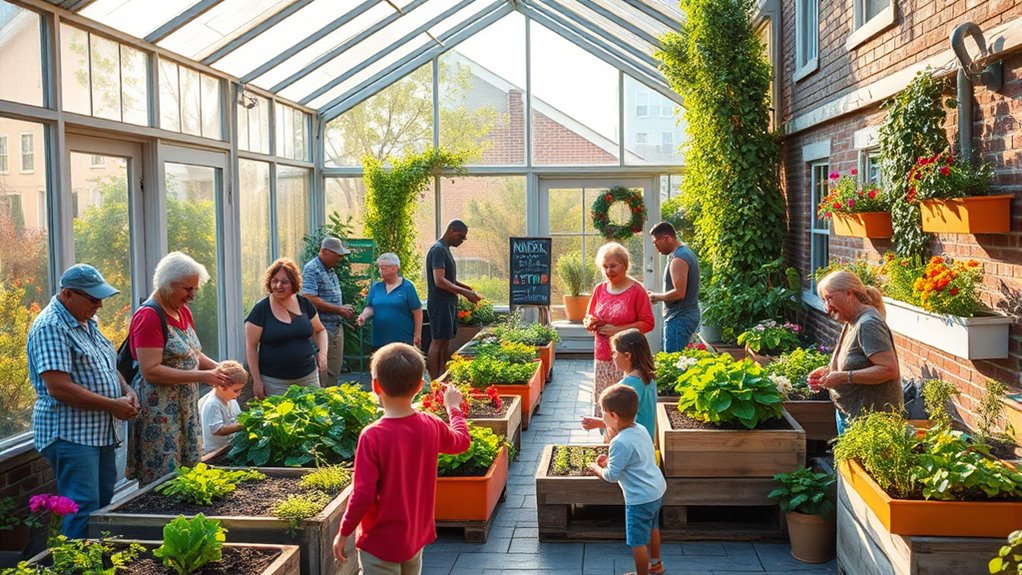
Community greenhouses are gaining popularity as a practical way to promote sustainability and local food production. They serve as essential tools for urban farming, allowing neighborhoods to grow fresh produce close to home and reduce reliance on long-distance food supply chains.
Community greenhouses promote sustainability and local food production by enabling urban farming close to home.
These greenhouses support sustainability initiatives by conserving resources, minimizing waste, and lowering carbon footprints. As you get involved, you’ll see how community greenhouses foster collaboration, education, and environmental awareness. Incorporating educational kits and activities can further enhance community engagement and learning about sustainable practices.
They turn vacant lots or underused spaces into productive hubs, making sustainable living more accessible. Community engagement plays a vital role in the success of these projects, encouraging residents to participate actively. Building awareness of sustainable practices can help communities optimize the benefits of greenhouses. Additionally, understanding local food systems can empower neighborhoods to create more resilient and self-sufficient communities. By participating in or supporting these initiatives, you contribute to healthier neighborhoods and a more resilient food system.
Furthermore, integrating nutritional knowledge about seeds like chia can inspire communities to include diverse, nutrient-rich options in their local food production. Community greenhouses are transforming urban spaces into thriving, eco-friendly environments that benefit everyone.
Designing Shared Spaces for Collective Gardening
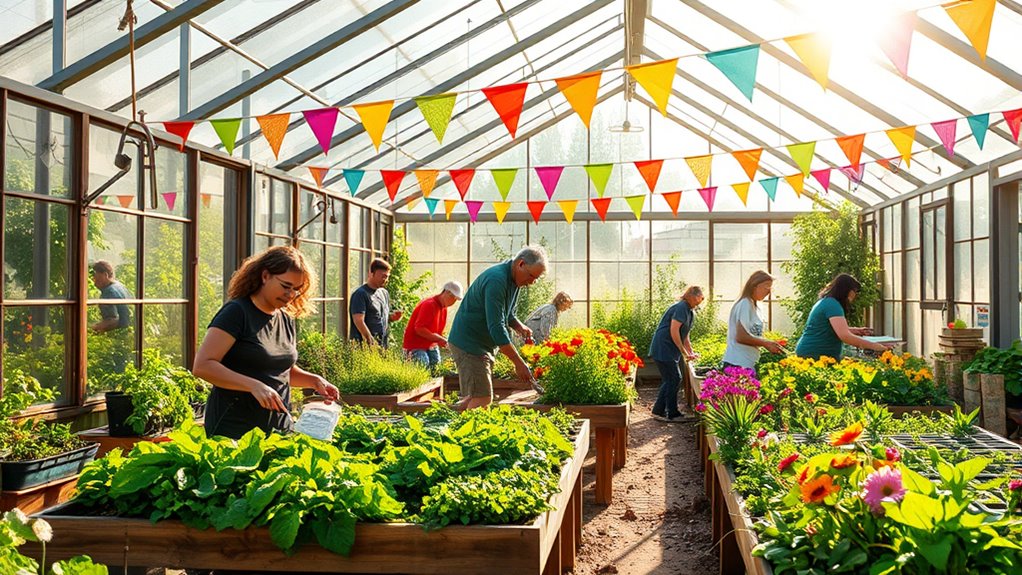
Creating effective shared spaces for collective gardening requires careful planning to guarantee accessibility, safety, and functionality. When designing a greenhouse for a neighborhood, consider how apartment gardening needs will influence layout and features. Use greenhouse design principles to maximize sunlight exposure, airflow, and ease of maintenance. Make certain pathways are wide enough for all users and incorporate raised beds or accessible planting zones for those with mobility challenges. Implementing space optimization techniques can help make the most of limited areas and improve overall usability. Additionally, thoughtful layout planning can facilitate community interaction and shared resource management. Incorporating vintage decor elements can add charm and a cozy atmosphere, encouraging residents to take pride in their shared space. Safety measures, like sturdy railings and non-slip surfaces, are essential. Incorporate storage areas for tools and supplies, and plan for water access that’s convenient for everyone. Considering the integration of aesthetic wall organization can also enhance visual interest and help keep tools and supplies orderly.
Educational Opportunities Through Neighborhood Greenhouses
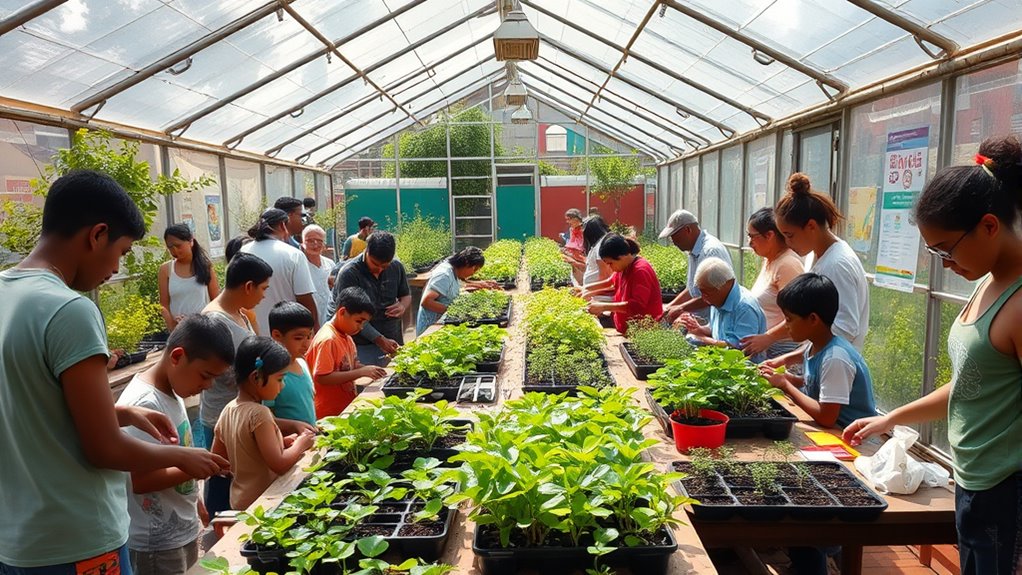
Neighborhood greenhouses offer a unique platform for hands-on learning about sustainability, plant biology, and responsible gardening practices. You can participate in seed exchanges to learn about plant diversity and local adaptation, fostering community knowledge. Composting workshops teach you how to turn organic waste into nutrient-rich soil, promoting eco-friendly habits. These activities help residents develop practical skills and deepen their connection to natural cycles. Engaging in local environmental initiatives can further enhance your understanding of sustainable practices. Additionally, participating in water-efficient gardening techniques can help reduce resource consumption and support conservation efforts. Exploring the benefits of meditation and mindfulness during garden activities can enhance your well-being and connection to nature. Incorporating personal development techniques like visualization during gardening can boost confidence in your abilities and foster a positive mindset. Through these programs, you gain confidence in growing food and caring for plants, all while building community bonds. Neighborhood greenhouses serve as accessible educational hubs that empower you to live more sustainably.
Enhancing Food Security With Local Cultivation

By growing your own food locally, you can substantially improve food security in your community. Greenhouses make it easier to diversify crops, reducing reliance on a single food source and increasing resilience against crop failures. With a variety of plants, you’ll better meet nutritional needs and adapt to changing conditions. Additionally, effective pest management strategies in greenhouses help protect your crops without relying heavily on chemical pesticides, ensuring healthier produce. Crop diversification also minimizes pest outbreaks, as pests tend to target specific plants. This integrated approach enhances food security by providing a reliable food supply year-round. Implementing solar-powered lighting in greenhouse lighting and monitoring systems can further optimize crop growth and quality. Incorporating best practices for pest control can significantly reduce the need for chemical interventions and promote sustainable cultivation. Emphasizing community involvement in greenhouse projects can foster shared responsibility and knowledge exchange, strengthening local food systems. Considering building codes and zoning regulations is essential for proper greenhouse placement and compliance.
Building Social Connections and Community Engagement
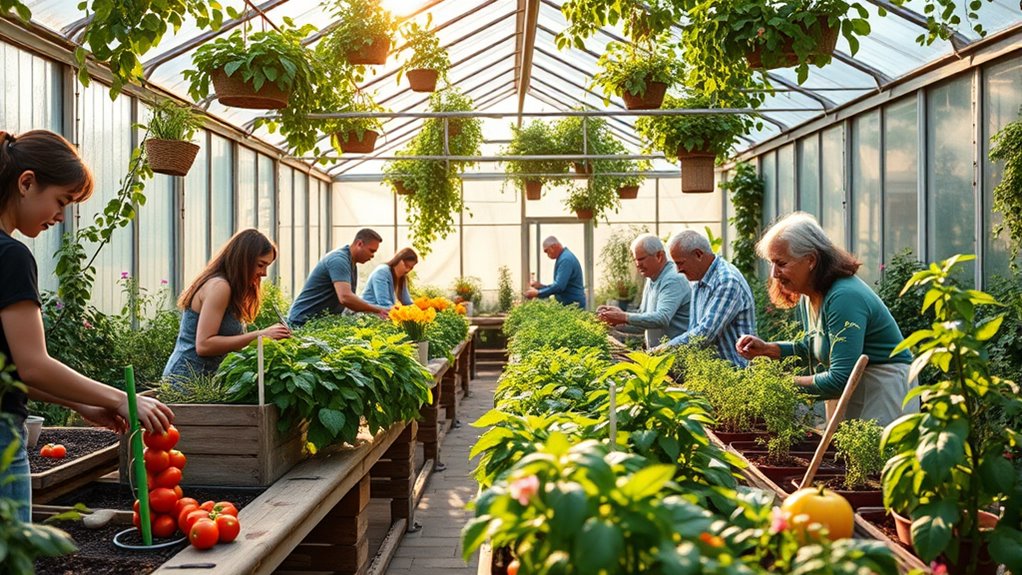
When you participate in community projects, you start growing stronger connections with your neighbors. Sharing efforts like gardening or local events helps build bonds that benefit everyone. You can also organize camping activities to foster teamwork and outdoor skills among community members. Incorporating diverse garden designs into shared spaces can inspire creativity and collective pride. Together, you’re cultivating not just plants, but a sense of belonging that lasts.
Growing Together
Building strong social connections is essential for creating vibrant communities where everyone feels valued and supported. Greenhouses serve as hubs for community engagement, fostering shared experiences that boost urban biodiversity and promote sustainable practices. When you participate in greenhouse activities, you help cultivate a sense of belonging and mutual support. These shared spaces encourage collaboration, allowing neighbors to exchange ideas and grow together.
| Activity | Benefits | Tools Needed |
|---|---|---|
| Planting sessions | Builds teamwork and skills | Seeds, soil, tools |
| Workshops | Share greenhouse technology tips | Guides, equipment |
| Harvesting | Connects community through shared effort | Containers, produce |
| Nature walks | Promote urban biodiversity awareness | Maps, guides |
| Community events | Strengthen neighborhood bonds | Decorations, food |
Cultivating Bonds
Cultivating bonds within your community creates a foundation for lasting relationships and a sense of belonging. When you participate in shared activities like maintaining a community greenhouse, you foster genuine community bonding.
Working together on projects encourages open communication and mutual support, strengthening connections among neighbors. Embracing shared responsibility means everyone contributes their skills and time, making the effort more rewarding and sustainable.
As you collaborate, you’ll find common interests and build trust, transforming acquaintances into friends. These strengthened relationships not only improve your neighborhood’s atmosphere but also inspire ongoing engagement.
Ultimately, cultivating bonds through collective effort helps create a resilient, connected community where everyone feels valued and invested in each other’s well-being.
Overcoming Challenges in Managing Shared Greenhouse Spaces
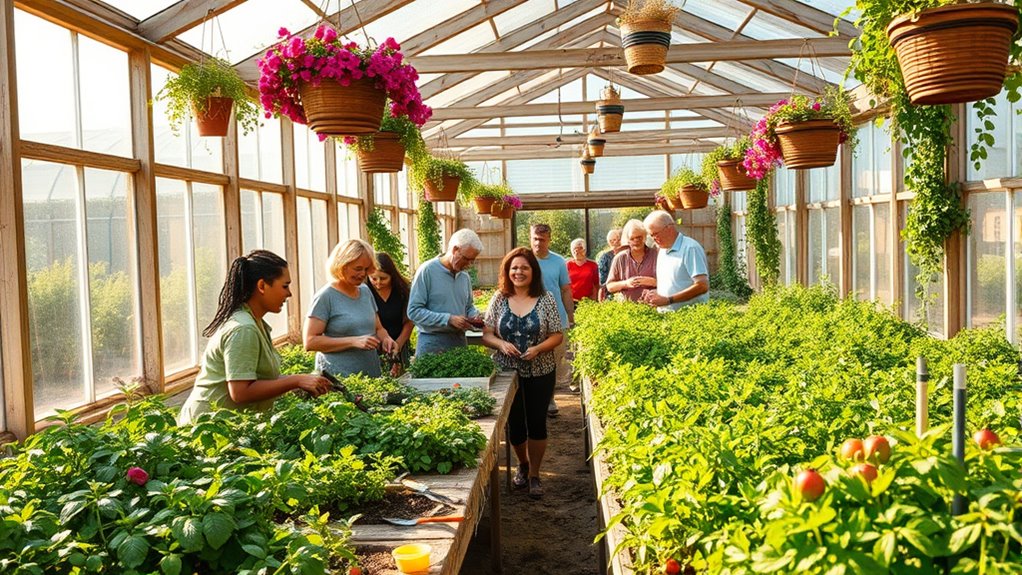
Managing shared greenhouse spaces can be challenging because it requires balancing the needs and expectations of multiple users. Effective resource allocation is key; you need to guarantee everyone has enough space, tools, and time to tend their plants without conflict. Clear guidelines help set boundaries and prevent misunderstandings.
When disagreements arise, conflict resolution becomes essential. Address issues promptly by encouraging open communication and listening to everyone’s concerns. Establishing a fair system for sharing responsibilities and resources reduces tension.
Regularly reviewing and adjusting rules keeps the environment cooperative and respectful. Remember, the goal is to create a welcoming space where all can thrive. Staying proactive about these challenges helps maintain harmony, ensuring the greenhouse remains a productive and enjoyable neighborhood resource.
Innovative Models and Success Stories From Neighborhood Projects

Neighborhood projects have embraced innovative models that transform shared green spaces into flourishing hubs of collaboration and learning. One successful approach is integrating vertical farming, which maximizes limited space by stacking crops vertically. This model allows communities to grow more food efficiently while conserving land and resources.
Hydroponic systems also play a key role, enabling residents to cultivate plants without soil, reducing water use, and speeding up growth cycles. These systems are easy to maintain and adapt to various scales, making them ideal for neighborhood projects.
Success stories highlight how residents come together to build and manage these setups, fostering a sense of ownership and shared purpose. Such innovative methods demonstrate how green spaces can evolve into productive, educational, and sustainable community resources.
Future Prospects for Community Greenhouses and Urban Agriculture
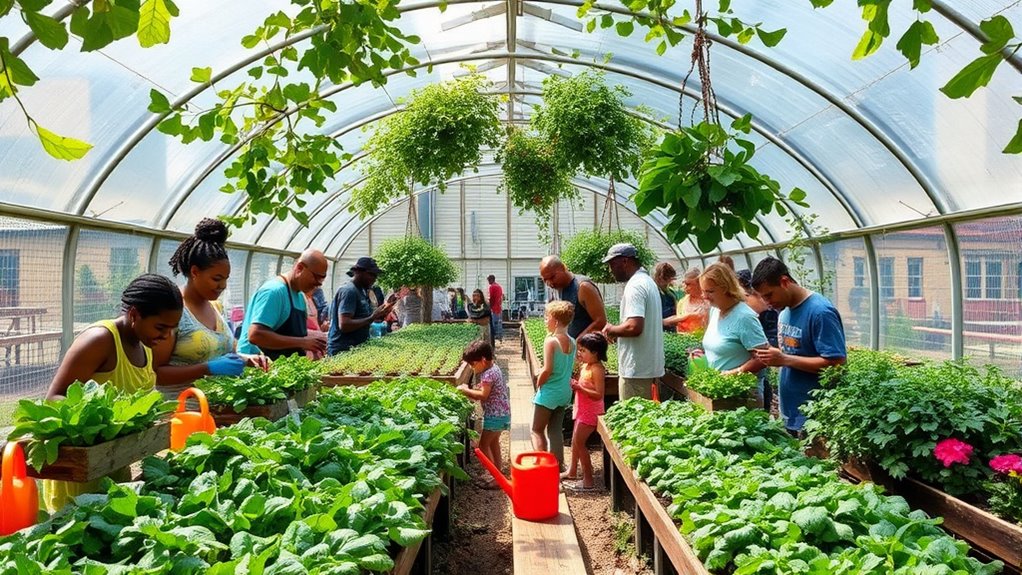
Looking ahead, the future of community greenhouses and urban agriculture promises exciting developments driven by technological advancements and growing environmental awareness. Vertical farming will become more prevalent, maximizing limited space and reducing resource use.
Digital automation will streamline operations, allowing you to monitor and control conditions remotely, increasing efficiency. Key innovations include:
- Integration of vertical farming systems to boost productivity in urban settings.
- Adoption of digital automation for precise watering, lighting, and climate control.
- Enhanced community engagement through smart platforms that facilitate shared ownership and knowledge exchange.
These advancements will make greenhouses more sustainable, accessible, and scalable, transforming neighborhoods into vibrant hubs of local food production. Your community can harness these tools to grow healthier, fresher produce while reducing environmental impact.
Frequently Asked Questions
How Do Community Greenhouses Fund Their Ongoing Maintenance Costs?
To cover maintenance costs, community greenhouses often rely on donation drives and membership fees. You can participate by donating funds during special events or becoming a member, which usually includes regular contributions.
These sources help sustain the greenhouse’s operations, ensuring it remains functional and accessible. Your involvement, through donations or memberships, directly supports ongoing maintenance and keeps the community resource thriving for everyone to enjoy.
What Legal or Zoning Restrictions Affect Establishing Neighborhood Greenhouses?
Imagine stepping into a lush neighborhood greenhouse, sunlight streaming through glass. Before setting this scene, you need to check local zoning ordinances to guarantee greenhouses are permitted in your area.
You might also need building permits, especially if the structure is large or permanent. These restrictions protect community aesthetics and safety, so understanding zoning laws and obtaining the right permits helps you create your green oasis without legal hiccups.
How Is Responsibility for Greenhouse Upkeep Typically Shared Among Members?
You’ll find that responsibility for greenhouse upkeep is often shared among members through volunteer responsibilities and shared maintenance schedules. Everyone pitches in regularly, guaranteeing tasks like watering, pruning, and cleaning are completed on time.
This collaborative approach keeps the greenhouse in good shape and fosters a sense of community. By establishing clear roles and schedules, you make sure that maintenance is manageable and that everyone contributes to the greenhouse’s success.
What Types of Crops Are Most Successful in Community Greenhouse Settings?
You might think only certain crops thrive in greenhouses, but with the right crop varieties, you can grow a wide range of successful plants. Vegetables like tomatoes, peppers, and leafy greens often excel due to controlled growing seasons, extending harvests beyond outdoor limitations.
Herbs and strawberries also flourish, creating a vibrant, productive space. Your greenhouse can become a haven for diverse crops, thanks to careful selection and year-round growing strategies.
How Do Community Greenhouses Impact Local Biodiversity and Ecosystem Health?
Community greenhouses boost local biodiversity and ecosystem health by supporting native plant preservation and providing habitat for pollinators. You can help by planting native species that attract bees and butterflies, which enhances pollinator support.
These greenhouses reduce the need for chemical pesticides, fostering a healthier environment. As a result, they create a vibrant, resilient ecosystem that benefits both wildlife and your community’s overall ecological balance.
Conclusion
Imagine community greenhouses as the heartbeat of your neighborhood, pulsing with life, growth, and shared purpose. By nurturing these green sanctuaries, you’re planting seeds of sustainability, friendship, and resilience that bloom into a vibrant tapestry of connection. As you embrace this collective journey, you become part of a flourishing garden where every leaf and smile helps our community thrive—turning urban spaces into lush, nurturing ecosystems for all to enjoy.
